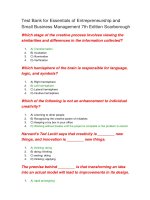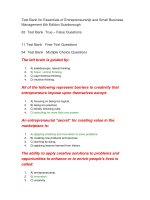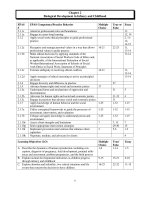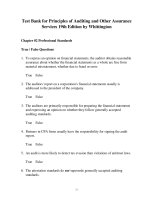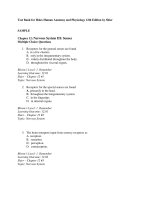Test bank for understanding human behavior and the social environment 11th edition by zastrow
Bạn đang xem bản rút gọn của tài liệu. Xem và tải ngay bản đầy đủ của tài liệu tại đây (132.89 KB, 5 trang )
Test Bank for Understanding Human Behavior and the Social Environment 11th Edition by Zastrow
Full
file at />Name:
Class:
Date:
Chapter 01
1. The text stated which of the following as a major thrust of social work?
a. Social workers link people with systems
b. Social work targets only how individuals behave
c. Social workers can force all systems to work with every client, no matter the problem
d. Social workers solve problems for their clients
ANSWER: a
2. The step in social work in which the problem or situation is analyzed and interpreted is called:
a. Assessment
b. Interpretation
c. Implementation
d. Intervention
ANSWER: a
3. The lifespan development is separated in this text according to which of the following:
a. Infancy and childhood/adolescence/young and middle adulthood/later adulthood
b. Infancy/childhood and adolescence/young and middle adulthood/later adulthood
c. Infancy/childhood and adolescence/young adulthood/middle and later adulthood
d. Infancy and childhood/adolescence and young adulthood/middle and later adulthood
ANSWER: a
4. _____ aspects of development concern how people think about themselves, others, and the environment around
them.
a. Biological
b. Social
c. Psychological
d. Environmental
ANSWER: c
5. Throughout each of the life periods—infancy and childhood, adolescence, young and middle adulthood, and later
adulthood—people tend to experience common life events related to all these developments except:
a. Biological
b. Psychological
c. Social
d. Behavioral
ANSWER: d
Copyright Cengage Learning. Powered by Cognero.
Full file at />
Page 1
Test Bank for Understanding Human Behavior and the Social Environment 11th Edition by Zastrow
Full
file at />Name:
Class:
Date:
Chapter 01
6. Typical development milestones include significant factors of each of the following except:
a. Biological
b. Psychological
c. Behavioral
d. Emotional
ANSWER: c
7. _____ is the vast range of differences among groups including those related to age, class, color, culture, disability,
ethnicity, gender, gender identity and expression, immigration status, political ideology, race, religion, sex, and
sexual orientation.
a. Cultural competence
b. Culture
c. Human diversity
d. Ethnocentrism
ANSWER: c
8. _____ is the amount of social respect or standing given to an individual based on occupation.
a. Prestige
b. Acclaim
c. Privilege
d. Power
ANSWER: a
9. Which of the following is not part of the second cluster of vital concepts for understanding human behavior?
a. Empowerment
b. Cultural competency
c. Strengths perspective
d. Resiliency
ANSWER: b
10. _____ strengths include strong family bonds, mutual concern among family members for each other’s welfare, and
the parents’ pride in their children and high hopes for their futures.
a. Family
b. Individual
c. Community
d. Group
ANSWER: a
Copyright Cengage Learning. Powered by Cognero.
Full file at />
Page 2
Test Bank for Understanding Human Behavior and the Social Environment 11th Edition by Zastrow
Full
file at />Name:
Class:
Date:
Chapter 01
11. ________ are made up of people with similar problems or issues who come together and provide each other with
support, information about how to cope with difficulties, and suggestions for resources.
a. Support groups
b. Community strength
c. Families
d. Clubs
ANSWER: a
12. _____ is the careful examination and evaluation of beliefs and actions to establish an independent decision about
what is true and what is not.
a. Critical thinking
b. Ethical evaluation
c. Value examination
d. Ethical decision making
ANSWER: a
13. A set of elements that are orderly and interrelated to make a functional whole is:
a. Homeostasis
b. A system
c. A boundary
d. A subsystem
ANSWER: a
14. A ______ system refers to any type of small group.
a. Macro
b. Micro
c. Mezzo
d. Macho
ANSWER: c
15. In the social action model, the text listed which of the following social work roles:
a. Facilitator
b. Analyst
c. Expert planner
d. Partisan
ANSWER: d
Copyright Cengage Learning. Powered by Cognero.
Full file at />
Page 3
Test Bank for Understanding Human Behavior and the Social Environment 11th Edition by Zastrow
Full
file at />Name:
Class:
Date:
Chapter 01
16. Assessment is the “doing” part of the process of social work.
a. True
b. False
ANSWER: False
17. The lifespan is divided into five main phases.
a. True
b. False
ANSWER: False
18. Social development and theories address people’s interaction with others around them in the social environment.
a. True
b. False
ANSWER: True
19. The term typical is used to describe levels of functioning that are considered appropriate for a particular age level.
a. True
b. False
ANSWER: True
20. “Every individual, group, family, and community has strengths” is one of the principles of the strengths perspective.
a. True
b. False
ANSWER: True
21. Another name for a natural support network is a helping network.
a. True
b. False
ANSWER: True
22. The National Association of Social Workers has a professional code of ethics.
a. True
b. False
ANSWER: True
Copyright Cengage Learning. Powered by Cognero.
Full file at />
Page 4
Test Bank for Understanding Human Behavior and the Social Environment 11th Edition by Zastrow
Full
file at />Name:
Class:
Date:
Chapter 01
23. Feedback is a special form of input in which a system receives information about its own performance.
a. True
b. False
ANSWER: True
24. Energy is the natural power of active involvement between people and their environments.
a. True
b. False
ANSWER: True
25. The broker is the person who calls attention to an issue.
a. True
b. False
ANSWER: False
26. Describe assessment and explain why it is important in social work.
ANSWER: N/A
27. List the six basic ethical principles in the National Association of Social Workers code of ethics.
ANSWER: N/A
28. You are an administrator for Batter-Out, an agency for the prevention of domestic violence. Your board of directors
has requested data to determine if your agency’s resources are being adequately invested. Draft a plan clearly
delineating your expected output and your outcomes.
ANSWER: N/A
29. When child maltreatment is suspected, should children be allowed to remain in their own home? How much risk of
child maltreatment is too much risk? What effect does it have on children to be removed from their home?
ANSWER: N/A
30. Identify and describe the following social work roles: empowerer, activist, and mediator. With which of these roles
would you have the most difficulty as a social worker? Why?
ANSWER: N/A
Copyright Cengage Learning. Powered by Cognero.
Full file at />
Page 5
